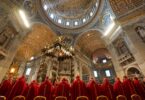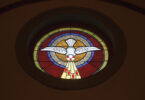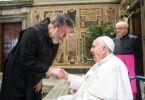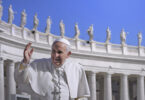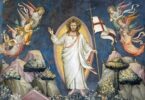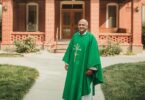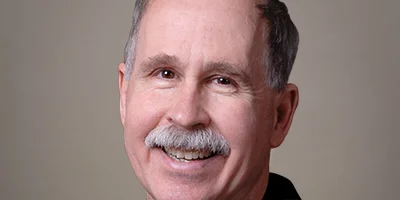
Father Mike Stubbs is the pastor of Holy Cross Parish in Overland Park and has a degree in Scripture from Harvard University.
by Father Mike Stubbs
In almost every church along the way to Santiago de Compostela, a long stretch of about 450 miles, I saw a statue of St. James, or “Santiago” in Spanish.
He was presented in two different ways. First of all, he often appears dressed as a pilgrim. That is because the pilgrims traveling to visit the tomb of St. James at Santiago de Compostela closely identify with him. It was only natural that he would assume their traits. Accordingly, he would be dressed in the cloak of a pilgrim, holding a walking staff with a gourd attached to it, wearing a hat pinned with a scallop shell, and carrying a Bible. These are the items that would identify a person as a pilgrim to Santiago de Compostela during the Middle Ages.
The gourd would serve as a water jug.
The other items are self-explanatory, except for the scallop shell, which could be used as a spoon. But more important, it is a symbol for the city of Santiago, which is fairly close to the sea. A few miles farther lies Finisterre, which literally means “end of the earth.” During the Middles Ages, the pilgrims who reached that point believed that they had arrived at the drop-off point for the world. There was nothing beyond.
This was part of the attraction that the pilgrimage to Santiago held during the Middle Ages. It reflected the belief that St. James the Apostle had travelled all the way to Spain to preach the Gospel. In doing so, he was helping to spread the faith to the ends of the earth.
Did St. James actually go to Spain? We know that St. Paul wanted to. He wrote to that effect in his Letter to the Romans: “I have been longing for many years to visit you on my way to Spain” (15:23).
On the other hand, we also know that St. James was martyred in Jerusalem: “It was about this time that King Herod attacked certain members of the church. He beheaded James, the brother of John” (Acts 12:1-2). It is difficult for me to believe that St. James’ body ended up in Spain, over 1,000 miles away. At the same time, we know that the Christian faith spread very early to Spain and took firm hold there, whether it was through the efforts of St. James or the efforts of other missionaries.
That faith continued on, even after the conquest by the Muslim Moors. In the long struggles to regain Spain from the Moors, the Christians turned to St. James. “Santiago” became their battle cry. According to tradition, St. James himself appeared in one crucial battle to help the Christians. That brings up the second manner in which St. James is often portrayed — as “Matamorros,” the “Moor killer.”
He is mounted on a war horse, swinging a sword over his head. At his feet lie a few Moors he has defeated. This bellicose image may not appeal to us during this age of interfaith dialogue. We might hope for a more peaceful image. However, this image of St. James as a fighter can remind us that living out our faith involves a struggle — a struggle not always with external opponents, but with elements within as well.
The pilgrimage to Santiago reflects this journey of faith, beset with struggles. Pilgrims arrive in Santiago, hobbling with blisters on their feet and sore muscles from walking miles and miles, often under difficult conditions.
A little more than a week ago, I was perched on top of a mountain, while a fierce storm raged around me. The violent winds ripped my poncho to shreds — winds so strong that they, I later discovered, had brought down big tree limbs. The rain soaked me to the bone. I was so cold that I was afraid that hypothermia might set in. That was my worst day, during a week in which it rained every day.
But that is behind me. Now the sun is shining. The skies are blue. I have arrived in Santiago. It is worth the struggle.

